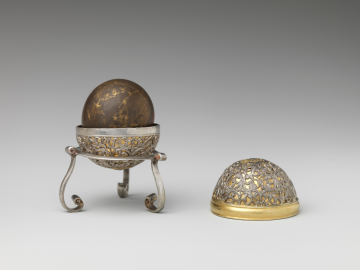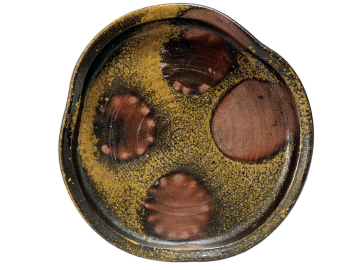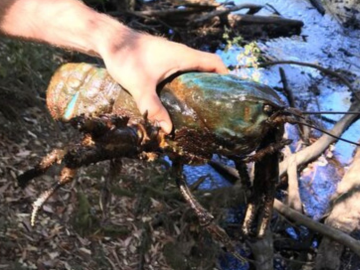The Alarm
Terry Mulhern
Lutaralipina – the giant freshwater crayfish (Astacopsis gouldi) – is the world’s largest freshwater invertebrate. It can live for up to 80 years, grow to almost a metre in length and weigh as much as six kilograms. This rare and secretive creature lurks beneath the surface of the creeks and rivers of northern Tasmania, where it is better known as simply ‘the lobster’. The lobster’s existence is threatened by illegal fishing and habitat loss. Under the banner of Lobster Tales, writer and researcher Terry Mulhern is chronicling the history and folklore surrounding this endangered Tasmanian icon.
*
The last dairy cow finishes crossing the road. The farmer waves and I re-start the engine, taking off slowly, so I don’t startle the stragglers. Mud and cow shit flick up as we continue down the valley on my latest lobster ‘hunting’ expedition. We rattle over a disused railway line. At a curve in the road, we leave the bitumen and head up a track towards an isolated farmhouse. At first, we can’t see anyone about, but dogs are barking, so there’s no need to ring the doorbell. A woman appears from behind the washing she’s been hanging out. She could be in her late 70s, but she moves like she’s much younger. She looks intrigued, rather than alarmed, by our presence. I get out of the car and approach her with a cheery “G’day”, and she responds in kind, adding “Are you lost?” I chuckle, and then begin my well-worn spiel about researching a book about lobsters. Her eyes widen, “That’s funny, we were only talking about lobsters last night…”. Before long, Dawn has told me about the old lobster she visits at a secret spot down on the river and of childhood adventures catching lobsters with her dad.
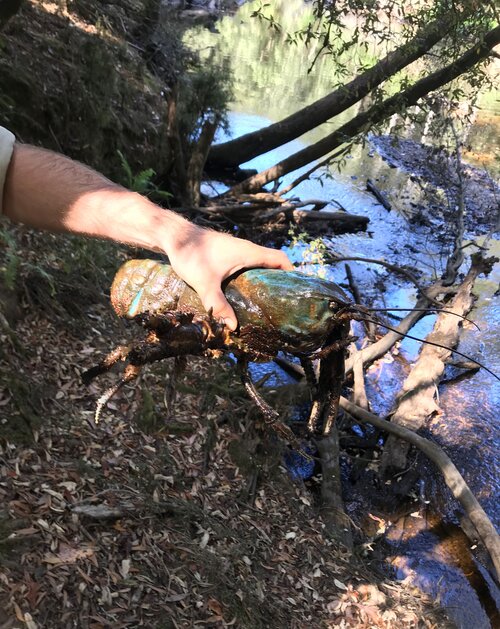
Over the years, the lobster has introduced me to zoologists and ecologists. It’s unlocked the backrooms of museums, libraries and art galleries where it hides in jars, books and paintings. It’s made me cups of tea in farmhouse kitchens and handed me beers in machinery sheds. Best of all, the lobster has unlocked memories. Everyone seems to have a story about how their dad or grandad used to catch lobsters. And that time he emptied a sugar bag of them onto the floor in the kitchen or pub.
*
I ask Dawn if the junction of the Alarm and Detention Rivers is on her property. This is the target of today’s expedition. In February 1828, assistant government surveyor John Helder Wedge camped at the confluence of these rivers, 12 km inland from Rocky Cape on the Bass Strait coast of northwest Tasmania. One member of his exploration party was ill and needed to rest. They were also running low on provisions, so while they rested, they fished. Wedge recorded that they caught “two very large fresh water Lobsters”. Although Tasmanian Aborigines have been eating lutaralipina for thousands of years, to the best of my knowledge, Wedge’s diary entry from 26 February 1828 is the earliest first-hand account of a white person catching and eating a giant freshwater crayfish. I’ve no doubt other whites caught and ate lobsters before Wedge – there were stock huts along the Mersey River as early as 1825 and the Van Diemen’s Land Company established their settlements at Circular Head (Stanley) and Emu Bay (Burnie) in 1826-7. But those earlier lobster-eaters lacked the wherewithal (or perhaps the basic literacy) to record this ‘momentous’ event.
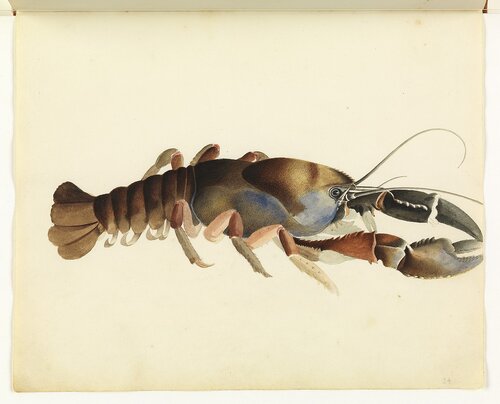
The river junction isn’t on Dawn’s property, it’s on her neighbour’s. She tells us we’ll find him putting in a new fence on the other side of the valley. The kids give the dogs a last pat, and we wave to Dawn as we drive off. Her directions are good, and the brand-new fence line comes into view. At the end of it is John. He’s quite chuffed to have a site of historical significance on his property and readily agrees to let us tramp about. I start unfolding my 1:25,000 topographical map in order to discuss the best plan of attack. He laughs out loud, informing me the old tracks marked on my ‘antiquated’ paper map are completely overgrown. He has something better. On an app on his smart phone John shows me all the new tracks he’s been pushing through the scrub and gives me advice on the best way to go.
We leave John working on his fence and start the expedition in earnest. I’d promised a leisurely pre-lunch stroll. It’s now almost midday and the sun has a real sting to it. However, my family know me well, and we are carrying plenty of food and water. “How long is this ‘short walk’ going to take?” I’m asked in a sceptical tone. “Oh, not long…It’s only a few kilometres”. Then under my breath “as the crow flies”.
Dawn’s side of the river is rolling green pastures and paddocks of rich red volcanic soil growing potatoes, carrots and onions. Hearty ‘meat and three veg’ country. On John’s side, it’s more ‘lean cuisine’. It’s noticeably drier and the soil is a thin powdery grey with patches of flinty white rocks. On satellite imagery the country between us and the river junction looks smooth and grassy. But looks can be deceiving. It’s mostly waist-high clumps of coarse button grass, interspersed with impenetrable head-high tea-tree scrub. Without John’s new tracks we would have been going nowhere fast. We trudge uphill away from his earthmoving equipment. From the crest, I spot the track we need. It starts off downhill in the direction we want, but then jags back around a broad swampy gully. We’ve only walked half a kilometre, but there’s no breeze and I’m already sweating. A few forest ravens croak in the distance.
*
“Chekov’s Gun” is a dramatic principle that goes something like this … if there is a rifle hanging over the fireplace in scene one, someone is going to be shot in scene three. As it happens, while everyone else was still in the car, John told me he’d seen quite a few snakes while pushing those new tracks. Today is the first hot sunny day, after a few cooler ones. The next few moments seem to go into slow motion. My nine-year old son and I have gotten a bit ahead. We are walking side-by-side on a track exactly one bulldozer wide. Rather than ripping up the button grass, the dozer has flattened it, so it’s like walking on golden straw. I glance down and my eye is caught by something black contrasting against the yellow. It’s where my boot is about to land. Somehow, my foot never reaches the ground. I’ve grabbed my son and it’s as though we are teleported back five metres. I’m shaking, breathing hard and trying my best (but failing) to remain calm. “Look” I say in a quavering voice, “a snake”.
Unlike me, the snake is completely unperturbed. It uncoils, slowly slithers a few metres, stops and turns its head, ever so slightly, to keep one eye on us. The girls now catch up and we introduce them to our new reptilian friend. It’s a big lowland copperhead (Austrelaps superbus). It’s impressive and beautiful, at least five feet long, matte black, but lightly coloured scales on its sides give a tantalizing hint of its pale underbelly.
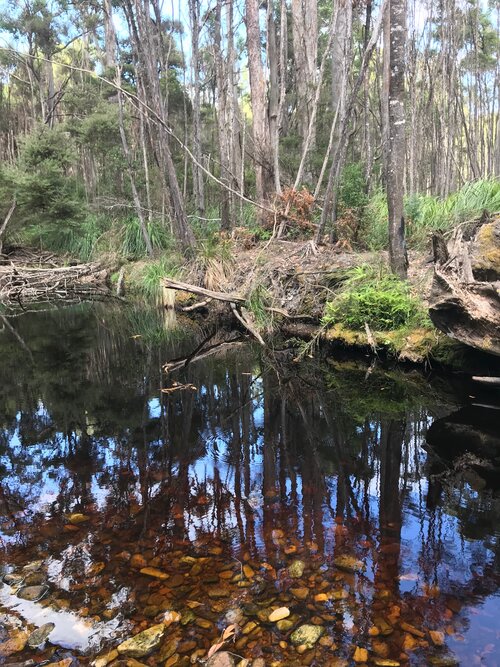
Eventually, the snake moves on and so do we, though somewhat more circumspect than before. Three-quarters of an hour later, we finally descend steeply towards Detention River. When we pause for a drink, we experience the delightful thrill of seeing a pink robin (Petroica rodinogaster) alight onto a branch right in front of us. Our path now takes us parallel to the river through a series of connected meadows, dotted with wallaby poo. The closely cropped grass is also scattered with wildflowers and patches of spongy moss. After a while, the meadows end abruptly. We are close to our destination, but a low ridge thickly cloaked in dry eucalypt forest blocks our way. We climb, picking our way carefully over fallen trees and then descend into a dense grove of ‘man’ ferns (Dicksonia antarctica). The urgent sound of the river draws us on. Suddenly, we emerge from the cool shade into bright sunlight. The river is wide and shallow, sparkling as it dances over smooth pebbles. Threading my way among the trees along the wooded bank, I peer ahead in expectation, trying to find were the smaller Alarm River merges with its larger cousin. Almost before we realise it, we are there. The Detention makes a right-angled bend. At the apex, the Alarm gurgles through a tangle of fallen timber into a deep wide pool.
*
We are standing where, almost 192 years ago to the day, John Helder Wedge caught those two lobsters. The far bank is undercut by the current and lying parallel to it is a huge log, washed down in a flood. Its moss-covered bulk slopes gently into the inky black water. In the darkness under that log I feel there are eyes watching us. Well, I hope there are.
The lobster’s range and numbers have contracted precipitously since Wedge’s time. It’s locally extinct in many rivers. Pollution from mining, agriculture and road building all taking their toll. Erosion following clearfell logging sends muddy water cascading into watercourses, fouling the lobsters’ feathery gills and covering the stream bed in silt, filling the rocky nooks and crannies where juveniles usually hide from predators. Even if the water is clean and clear, loss of stream-side trees removes the shade that is critical to keeping the water cold enough for these animals to survive. In the last decade, I’ve seen the Tasmanian summer become noticeably longer, hotter and drier. And that’s only going to get worse before it ever gets better.
Thankfully, other than just a couple of faded beer cans, there are none of the other tell-tale signs of illegal fishing here. Lobsters may have been totally protected for more than 20 years, but it’s all too common to hear of people still catching and eating them. At more accessible sites, it’s not unusual to find baited lines or ‘opera house’-style traps – illegal in Tasmania and a danger to lobster, platypus and rakali alike. Cultural change is needed, and education is the key. You won’t value and protect something you’ve never heard of.
So, whenever I can, I write and speak about the lobster. About the surprising ways it is enmeshed in the culture of this island that I love. I talk about science, history and language. About people and places. About memories. And I hope that change will come before memories of the lobster are all that we have.
All photographs by Terry Mulhern
